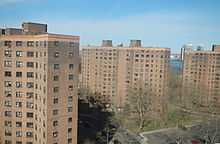Baruch Houses
Coordinates: 40°43′03″N 73°58′38″W / 40.7175°N 73.9772°W

Bernard M. Baruch Houses, or Baruch Houses, is a public housing development built by the New York City Housing Authority (NYCHA) on the Lower East Side of Manhattan.[1] The development is named after Bernard Baruch, a Wall Street trader, economic advisor during World War I and World War II, and confidant to six presidents.[1] Baruch Houses is bounded by Franklin D. Roosevelt East River Drive to the east, E. Houston Street to the north, Columbia Street to the west, and Delancey Street to the south.[1] Nearby housing developments include the Gompers Houses, west of here.
The complex, the largest NYCHA development in Manhattan, occupies 27.64 acres (111,900 m2) (equivalent to fifteen blocks), of which buildings cover 13.4%, a percentage similar to that of most "tower in the park" project designs.[2] It has 2,194 apartments, which house an estimated 5,397 people.[1][3] These apartments are distributed throughout 17 buildings.[1] Baruch Houses I is seven stories tall, Baruch Houses XI, XIII, and XV are thirteen stories tall, and the rest (II-X,XII,XIV,XVI-XVII) are fourteen stories tall.[4] Combined, these buildings have 2,900,000 square feet (270,000 m2).[1][3]
Baruch Houses Addition, or Baruch Addition, is an eighteenth building for seniors, built in 1977.[4][5] Baruch Addition is located on Columbia Street, at the start of Rivington Street, and has 197 units in twenty-three stories.[3][4][5]
The complex was designed by Emery Roth & Sons.[2] Baruch Houses was completed June 30, 1959.[1] Between the construction of LaGuardia Houses and Baruch Houses, 1,650 people were displaced in 1953-1954.[6]
Roberto Napoleon is the current Resident Association President for Baruch Houses.[7] Samuel Manguel is the current Resident Association President for Baruch Houses Addition.[7]
References
- ↑ 1.0 1.1 1.2 1.3 1.4 1.5 1.6 "BARUCH HOUSES/BARUCH ADDITION". NYCHA Housing Developments. New York: New York City Housing Authority. Retrieved 16 January 2010.
- ↑ 2.0 2.1 Plunz, Richard (1990). A History of Housing in New York City (reprint, illustrated ed.). New York: Columbia University Press. pp. 268–269. ISBN 978-0-231-06297-8. Retrieved 2010-01-16.
- ↑ 3.0 3.1 3.2 "Land Rich-Pocket Poor". mbpo.org. New York: Manhattan Borough President's Office. Retrieved 16 January 2010.
- ↑ 4.0 4.1 4.2 "Bernard M. Baruch Houses, New York City". Emporis.com. New York: Emporis Corporation. Retrieved 16 January 2010.
- ↑ 5.0 5.1 "Guide to applying for public housing". New York City Housing Authority. Retrieved 16 January 2010.
- ↑ Mele, Christopher (2000). "3". Selling the Lower East Side: culture, real estate, and resistance in New York City. Globalization and community 5 (illustrated ed.). Twin Cities: University of Minnesota Press. p. 118. ISBN 978-0-8166-3182-7. Retrieved 2010-01-16.
- ↑ 7.0 7.1 "Manhattan South District CCOP Office". Residents' Corner. New York: New York City Housing Authority. Retrieved 16 January 2010.